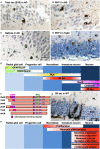Tau Pathology and Adult Hippocampal Neurogenesis: What Tau Mouse Models Tell us?
- PMID: 33643196
- PMCID: PMC7902892
- DOI: 10.3389/fneur.2021.610330
Tau Pathology and Adult Hippocampal Neurogenesis: What Tau Mouse Models Tell us?
Abstract
Adult hippocampal neurogenesis (AHN) has been widely confirmed in mammalian brains. A growing body of evidence points to the fact that AHN sustains hippocampal-dependent functions such as learning and memory. Impaired AHN has been reported in post-mortem human brain hippocampus of Alzheimer's disease (AD) and is considered to contribute to defects in learning and memory. Neurofibrillary tangles (NFTs) and amyloid plaques are the two key neuropathological hallmarks of AD. NFTs are composed of abnormal tau proteins accumulating in many brain areas during the progression of the disease, including in the hippocampus. The physiological role of tau and impact of tau pathology on AHN is still poorly understood. Modifications in AHN have also been reported in some tau transgenic and tau-deleted mouse models. We present here a brief review of advances in the relationship between development of tau pathology and AHN in AD and what insights have been gained from studies in tau mouse models.
Keywords: Alzheimer's disease; dentate gyrus; neurogenesis; tau; tauopathy.
Copyright © 2021 Houben, Homa, Yilmaz, Leroy, Brion and Ando.
Conflict of interest statement
The authors declare that the research was conducted in the absence of any commercial or financial relationships that could be construed as a potential conflict of interest.
Figures

Similar articles
-
The relationship between adult hippocampal neurogenesis and cognitive impairment in Alzheimer's disease.Alzheimers Dement. 2024 Oct;20(10):7369-7383. doi: 10.1002/alz.14179. Epub 2024 Aug 21. Alzheimers Dement. 2024. PMID: 39166771 Free PMC article. Review.
-
Focused ultrasound-induced blood-brain barrier opening improves adult hippocampal neurogenesis and cognitive function in a cholinergic degeneration dementia rat model.Alzheimers Res Ther. 2019 Dec 27;11(1):110. doi: 10.1186/s13195-019-0569-x. Alzheimers Res Ther. 2019. PMID: 31881998 Free PMC article.
-
Molecular mechanisms of altered adult hippocampal neurogenesis in Alzheimer's disease.Mech Ageing Dev. 2021 Apr;195:111452. doi: 10.1016/j.mad.2021.111452. Epub 2021 Feb 5. Mech Ageing Dev. 2021. PMID: 33556365 Review.
-
Adult Hippocampal Neurogenesis in Alzheimer's Disease: An Overview of Human and Animal Studies with Implications for Therapeutic Perspectives Aimed at Memory Recovery.Neural Plast. 2022 Jan 15;2022:9959044. doi: 10.1155/2022/9959044. eCollection 2022. Neural Plast. 2022. PMID: 35075360 Free PMC article. Review.
-
Interneuron Accumulation of Phosphorylated tau Impairs Adult Hippocampal Neurogenesis by Suppressing GABAergic Transmission.Cell Stem Cell. 2020 Mar 5;26(3):331-345.e6. doi: 10.1016/j.stem.2019.12.015. Epub 2020 Jan 23. Cell Stem Cell. 2020. PMID: 31978364
Cited by
-
Early postnatal defects in neurogenesis in the 3xTg mouse model of Alzheimer's disease.Cell Death Dis. 2023 Feb 18;14(2):138. doi: 10.1038/s41419-023-05650-1. Cell Death Dis. 2023. PMID: 36801910 Free PMC article.
-
Functional Deficits of 5×FAD Neural Stem Cells Are Ameliorated by Glutathione Peroxidase 4.Cells. 2022 May 28;11(11):1770. doi: 10.3390/cells11111770. Cells. 2022. PMID: 35681465 Free PMC article.
-
From cradle to grave: neurogenesis, neuroregeneration and neurodegeneration in Alzheimer's and Parkinson's diseases.Neural Regen Res. 2022 Dec;17(12):2606-2614. doi: 10.4103/1673-5374.336138. Neural Regen Res. 2022. PMID: 35662189 Free PMC article. Review.
-
Populations of Tau Conformers Drive Prion-like Strain Effects in Alzheimer's Disease and Related Dementias.Cells. 2022 Sep 26;11(19):2997. doi: 10.3390/cells11192997. Cells. 2022. PMID: 36230957 Free PMC article. Review.
-
Neurogenesis in aging and age-related neurodegenerative diseases.Ageing Res Rev. 2022 Jun;78:101636. doi: 10.1016/j.arr.2022.101636. Epub 2022 Apr 29. Ageing Res Rev. 2022. PMID: 35490966 Free PMC article. Review.
References
-
- Brion JP, Passareiro H, Nunez J, Flament-Durand J. Mise en évidence immunologique de la protéine tau au niveau des lésions de dégénérescence neurofibrillaire de la maladie d'Alzheimer. Arch Biol. (1985) 95:229–35.
Publication types
LinkOut - more resources
Full Text Sources
Other Literature Sources

